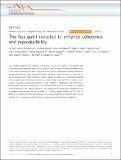| dc.contributor.author | Birenbaum, Jeffrey | |
| dc.contributor.author | Sears, Adam P | |
| dc.contributor.author | Hover, David | |
| dc.contributor.author | Gudmundsen, Ted J. | |
| dc.contributor.author | Rosenberg, Danna | |
| dc.contributor.author | Samach, Gabriel | |
| dc.contributor.author | Weber, S | |
| dc.contributor.author | Yoder, Jonilyn L. | |
| dc.contributor.author | Clarke, John | |
| dc.contributor.author | Kerman, Andrew J. | |
| dc.contributor.author | Yan, Fei | |
| dc.contributor.author | Gustavsson, Simon | |
| dc.contributor.author | Kamal, Archana | |
| dc.contributor.author | Orlando, Terry Philip | |
| dc.contributor.author | Oliver, William D | |
| dc.date.accessioned | 2017-05-17T14:39:40Z | |
| dc.date.available | 2017-05-17T14:39:40Z | |
| dc.date.issued | 2016-11 | |
| dc.date.submitted | 2015-08 | |
| dc.identifier.issn | 2041-1723 | |
| dc.identifier.uri | http://hdl.handle.net/1721.1/109140 | |
| dc.description.abstract | The scalable application of quantum information science will stand on reproducible and controllable high-coherence quantum bits (qubits). Here, we revisit the design and fabrication of the superconducting flux qubit, achieving a planar device with broad-frequency tunability, strong anharmonicity, high reproducibility and relaxation times in excess of 40 μs at its flux-insensitive point. Qubit relaxation times T₁ across 22 qubits are consistently matched with a single model involving resonator loss, ohmic charge noise and 1/f-flux noise, a noise source previously considered primarily in the context of dephasing. We furthermore demonstrate that qubit dephasing at the flux-insensitive point is dominated by residual thermal-photons in the readout resonator. The resulting photon shot noise is mitigated using a dynamical decoupling protocol, resulting in T₂≈85 μs, approximately the 2T₁ limit. In addition to realizing an improved flux qubit, our results uniquely identify photon shot noise as limiting T₂ in contemporary qubits based on transverse qubit–resonator interaction. | en_US |
| dc.language.iso | en_US | |
| dc.publisher | Nature Publishing Group | en_US |
| dc.relation.isversionof | http://dx.doi.org/10.1038/ncomms12964 | en_US |
| dc.rights | Creative Commons Attribution 4.0 International License | en_US |
| dc.rights.uri | http://creativecommons.org/licenses/by/4.0/ | en_US |
| dc.source | Nature | en_US |
| dc.title | The flux qubit revisited to enhance coherence and reproducibility | en_US |
| dc.type | Article | en_US |
| dc.identifier.citation | Yan, Fei; Gustavsson, Simon; Kamal, Archana; Birenbaum, Jeffrey; Sears, Adam P; Hover, David; Gudmundsen, Ted J. et al. “The Flux Qubit Revisited to Enhance Coherence and Reproducibility.” Nature Communications 7 (November 3, 2016): 12964. © 2016 Macmillan Publishers Limited, part of Springer Nature. | en_US |
| dc.contributor.department | Massachusetts Institute of Technology. Department of Electrical Engineering and Computer Science | en_US |
| dc.contributor.department | Massachusetts Institute of Technology. Department of Physics | en_US |
| dc.contributor.department | Massachusetts Institute of Technology. Research Laboratory of Electronics | en_US |
| dc.contributor.mitauthor | Yan, Fei | |
| dc.contributor.mitauthor | Gustavsson, Simon | |
| dc.contributor.mitauthor | Kamal, Archana | |
| dc.contributor.mitauthor | Orlando, Terry Philip | |
| dc.contributor.mitauthor | Oliver, William D | |
| dc.relation.journal | Nature Communications | en_US |
| dc.eprint.version | Final published version | en_US |
| dc.type.uri | http://purl.org/eprint/type/JournalArticle | en_US |
| eprint.status | http://purl.org/eprint/status/PeerReviewed | en_US |
| dspace.orderedauthors | Yan, Fei; Gustavsson, Simon; Kamal, Archana; Birenbaum, Jeffrey; Sears, Adam P; Hover, David; Gudmundsen, Ted J.; Rosenberg, Danna; Samach, Gabriel; Weber, S; Yoder, Jonilyn L.; Orlando, Terry P.; Clarke, John; Kerman, Andrew J.; Oliver, William D. | en_US |
| dspace.embargo.terms | N | en_US |
| dc.identifier.orcid | https://orcid.org/0000-0002-4674-2806 | |
| dc.identifier.orcid | https://orcid.org/0000-0002-7069-1025 | |
| dc.identifier.orcid | https://orcid.org/0000-0001-5430-9837 | |
| dc.identifier.orcid | https://orcid.org/0000-0002-4436-6886 | |
| mit.license | PUBLISHER_CC | en_US |
